
FT-1000D
"The Best of the
Best"
200W HF ALL MODE TRANSCEIVER
Designed with no spared effort or expense for optimum performance and operability, the FT-1000D is the fruit of over 25,000 man-hours of intensive research and development by Yaesu’s top design engineers. Instead of merely offering incremental improvements on existing designs or adding bells and whistles to an old model, the FT-1000D project involves a wholly new approach to the application of the latest digital and RF technologies to today’s most demanding needs on the HF bands. Extensive surface-mount component technology allowed six microprocessors and five Direct Digital Synthesizers to be harmoniously integrated with a simple operator interface into a highly reliable full-featured transceiver optimized for serious HF applications.
Five
Direct Digital Synthesizers
Developed independently by a specially
appointed in-house engineering research team, two 10-bit Digital
Synthesizers in the FT-1000D provide exceptionally clean vfo sources to
drive the PLL local oscillators, resulting in very low carrier noise on
transmitted signals, and wide receiver blocking dynamic range. The fast,
stable PLL locking time and three additional 8-bit DDSs controlling the IF
functions result in unsurpassed IF control, a tuning feel as smooth as an
analog vfo, and quick transmit/receive turnaround (typically 18 ms) for
QSK CW and high-performance digital ARQ modes. To take full advantage of
this level of synthesis the FT-1000D is supplied as standard with a 2-ppm
(0 to 50 °C) master oscillator, with a 0.5-ppm (-10 to +60 °C) TCXO
optional.
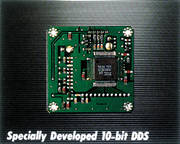 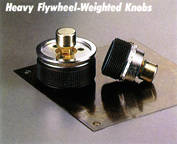 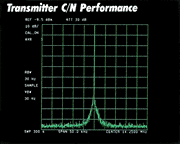 |
Flexible
Receiver Front-end With Broad Dynamic Range
Excellent receiver
strong signal handling results from fourteen 5-pole main channel front end
bandpass filters (plus eleven optional sub channel bandpass filters)
followed by a switchable cascode dual JFET RF amplifier and
double-balanced mixer ring using four high-IDSS JFETs. According to band
conditions, you can choose between the preamp, direct mixer feed, or
direct feed with attenuation selectable in three 6-dB steps (to coincide
with S-units). Typical measured two-tone dynamic range is 108 dB (+32 dBm
3rd order IP) with the RF amplifier off, and a noise floor of —138 dB with
it on (50 kHz spacing at 14.260 MHz, 500 Hz BW, CW mode with no
attenuation).
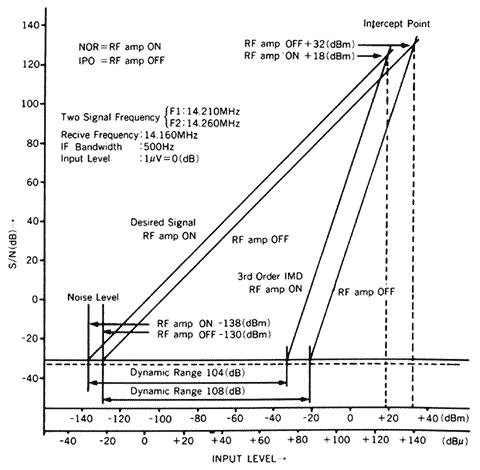
Simultaneous Dual (Unlimited) Frequency Reception
Dual
receiver front ends, IF strips and vfos allow simultaneous reception and
display of two different frequencies, even in different modes and with
different IF bandwidths. A single RX MIX control allows adjusting the
relative volume of each channel without having to twiddle multiple knobs.
Unique to the FT-1000D, each vfo has its own flywheel-weighted tuning
knob, requiring no confusing pushbutton selections to tune either
frequency. The audio of each vfo can be monitored mixed or split between
each ear (with headphones or external stereo amp). Also unlike any other
radio, the eleven additional filters in the BPF-1 Sub-Vfo Bandpass Filter
option allow the two frequencies to be up to 29.9 MHz apart (using a
second antenna). For example, you can monitor WWV on 10 MHz while
simultaneously working SSB or CW on 28 MHz, and freely tune either or both
frequencies without pushing a single button. (Without the BPF-1 option the
main and sub vfos must share the same antenna and bandpass filter). Note
that with or without the BPF-1, a separate receiving antenna can be
connected and selected from the front panel —important for serious 160m
operations. The FT-1000D’s dual receive design allows frequency, mode and
filter diversity reception, plus antenna diversity reception with the
BPF-1 option.
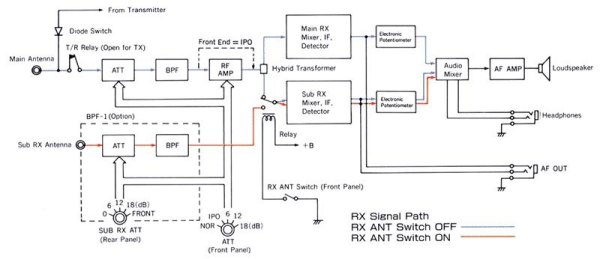
QRM
Rejection Systems
A tunable (±1.2 kHz) notch filter in the 100 kHz
4th IF provides more than 40 dB rejection of unwanted heterodynes or CW
signals in all modes (except FM). A sharp 4-pole tunable audio peak filter
allows comfortable separation of CW signals in crowded bands. IF shift
provides fine adjustment of the filter center frequency up to ±1.12 kHz on
the IF bandpass, and single-control IF width allows narrowing the actual
IF passband without affecting the center frequency. Separate wide and
narrow pulse noise blanker circuits can be selected independently for both
"woodpecker" and switching transient noise suppression.

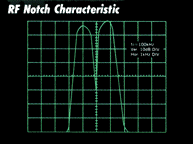  |
Optimized
Digital Communications Modes
Special provisions for RTTY/AMTOR and
packet modes include an independent built-in microprocessor to control
AFSK generation for RTTY/AMTOR, providing selectable 2125- or 1275- Hz
Mark tones and 170-, 425-, and 850-Hz shifts, with upper or lower shift
selectable with RTTY mode button. The display can show the Mark frequency,
or be loaded with any desired offset. The 500-Hz BW crystal filters can be
selected for RTTY, AMTOR and 300 baud packet, and IF offset can be
selected from four standard settings matching most popular TNCs, so that
received signals are centered in the IF and the display shows the actual
center frequency of the two transmitted tones. Of course, any non-standard
tone pair/shift can also be accommodated with manual IF shift and
independent display offset adjustment (from the front panel). The PACKET
mode button selects LSB, or FM (with 1000-Hz shift). A separate RTTY
terminal unit and TNC can both be connected independently at the rear
panel. FAX and SSTV can also be used in SSB modes.
Flexible
Mode and IF Filter Selection
Each receiver IF (Main and Sub) has
its own vfo on each of the ten bands, and each of these vfos has two
sub-band channels per band. Each of these 40 tunable vfo channels plus the
99 knob selectable tunable memories have independently selectable modes
and receiving IF filters. For the main receiver, four crystal filters are
provided as standard in the 8.2 MHz 2nd IF, and two in the 455-kHz 3rd IF,
providing bandwidths of 250 and 500 Hz, and 2.0, 2.4 and 6 kHz with four
optional filters available for the main 455-kHz IF. In addition, the sub
receiver comes with a 2.4 kHz BW filter in the 7.68 MHz 2nd IF and another
2.4-kHz filter in the 455-kHz 3rd IF, with a 3rd IF 600-Hz narrow filter
available as an option. Selecting filters does not affect the receiving
frequency, so for example, you can switch bandwidths from 2.4 kHz to 500
Hz during a CW QSO without retuning.
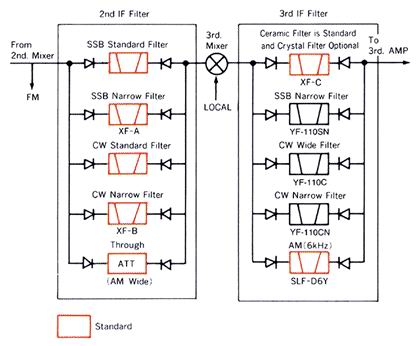
Up to 200
Watts Transmitter Output
While other transceivers offer maximum
output of 100 or 150 watts, the FT-1000D gives you clean, continuously
adjustable output from 20 to a full 200 watts (50 watts AM carrier), for
that extra edge needed in pileups, or to easily drive big linears to the
legal limit. The clean DDS-derived local signals combined with 30-volt Vcc
to the (MRF422) final transistors results in a typical transmitter
3rd-order IMD of —36 dB (at 150W PEP). An extended transmit duty cycle of
30 minutes cool, quiet keydown power (@ 100W) results from employing a
10-inch wide squirrel cage blower (instead of the usual fan) and internal
interlaced heat sinks. A separate RF PWR (ALC threshold) control allows
full adjustment of power output in all modes, and a transmitter RF (not
IF) monitor lets you hear just what you’re sending to the antenna. The
built-in quick response antenna tuner matches SWRs up to 3:1 on the
amateur bands, and includes 39 tuner-setting memories for instant recall
of previously stored settings. The antenna tuner controls are also
accessible by external computer via the CAT System.
 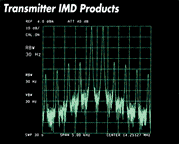 |
Special
Features for CW Operation
Along with the wide array of IF filters
and the tunable audio peak filter, the FT-1000D provides selectable bfo
offsets of 400-, 500-, 600-, and 700-Hz pitch, with matching CW spotting
oscillator (to zero-beat your transmitter while receiving) and transmit
sidetone. A novel PLL-controlled visual spotting indicator is also
provided to facilitate spotting. In addition to front panel speed control,
the built-in electronic squeeze keyer includes 15-step weight selection
from 1:3 to 1:4.5 dot/dash ratios. Key jacks are provided on both front
and rear panels. The CW carrier is injected at the USB side of the IF
center frequency, so you can switch between CW and USB without retuning.
  |
Enhanced
Integration = Simplified Control
To ensure simple operator
control, an 8-bit HD64180 master CPU works in concert with five supporting
microprocessors to manage the frequency synthesis and complex functions of
the FT-1000D. "Shifted" key functions have been eliminated, except for
numeric frequency entry on the keypad, which otherwise provides one-touch
instant band selection. Separate buttons are provided for all other
significant functions including vfo, mode, and IF and audio filter
selection. A detented rotary selector is used for the 99 memories, which
can be independently tuned or have their mode or IF filter selection
changed directly, just like a vfo. The Clarifier (receive/transmit offset)
can be adjusted and is displayed and stored independently of the operating
frequency, being added to the main display when either the transmit or
receive clarifier is activated. Clearing either clarifier retains the
offset on its separate display for instant reuse. The CAT (Computer-Aided
Transceiver) System in the FT-1000D allows control of major functions from
an external personal computer. The FT-1000D is supported by most DX and
contest logging programs.
 |
DVS-2
Digital Voice Recording Option
Designed especially for serious
DXing and contesting, the DVS-2 option can be used to store receiver audio
continuously. Pressing the STOP button saves the last 16 seconds of audio
in digital memory, which can then be played back through the transceiver’s
loudspeaker or earphones (repeatedly, if desired). In its transmitting
mode, for contest or DX calls, the DVS-2 can record either two 8-second
messages or four 4-second messages via the microphone, and then play back
selected messages on the air at the touch of a button.
FT-1000D
includes following accessories:
XF-C 455 kHz SSB 2.4
kHz Filter
YF-110SN 445 kHz SSB 2.0 kHz Filter
YF-110CN 455 kHz CW
250 Hz Filter
XF-4555MC 455 kHz CW 600 Hz Filter
BPF-1 Band Pass
Filter for Cross Band Receive
TCXO-1 Temperature Compensated Crystal
Oscillator

|
SPECIFICATIONS | |
| 0 | |
| GENERAL | 0 |
|
RX Frequency Range: |
100 kHz ~ 30 MHz |
|
TX Frequency ranges: |
160 ~ 10m amateur bands only |
|
Freq. Accuracy: |
<±5 ppm (except FM ±100 Hz) |
|
Freq. Stability: |
<±2 ppm (0 °C ~ 50°C) (except FM ±200 Hz) |
|
0 |
<±0.5 ppm (-10°C ~ 60°C) w/TCXO-1 (FM ±150 Hz 0°C ~ 50°C) |
|
Emission Modes: |
LSB, USB (J3E), CW (A1A), FSK (J1D, J2D), AM (A3E), FM (F3E) |
|
Basic Frequency Steps: |
10 Hz for J3E, A1A and J1D |
|
0 |
100 Hz for AM and FMA3E, F3E and J2D |
|
Antenna Impedance: |
16.5 to 150 Ohm, 50 Ohm nominal |
|
0 | |
|
Supply Voltage: |
100, 110, 117, 200, 220 or 234 VAC, 50/60 Hz |
|
Power Consumption (approx.): |
95 VA Receive, 1050 VA for 200 watts transmit |
|
Dimensions (WHD): |
420 x 150 x 375 mm |
|
Weight (approx.): |
51 lbs. (25.5 kg.) |
|
0 | |
|
TRANSMITTER |
0 |
|
Power Output: |
adjustable up to 200 watts (50 watts AM Carrier) |
|
Duty Cycle: |
100% @ 100 watts, 50% @ 200 watts (FM & RTTY, 3-minute TX) |
|
Modulation Types: |
SSB: Balanced, Filtered Carrier |
|
0 |
AM: Low level (early stage) |
|
0 |
FM: Variable Reactance |
|
0 |
FSK: Audio Frequency Shift Keying |
|
Maximum FM Deviation: |
±2.5 kHz |
|
FSK Shift Frequencies: |
170, 425 and 850 Hz |
|
Packet Shift Frequencies: |
200, 1000 Hz |
|
Harmonic radiation: |
at least 50dB below peak output |
|
SSB carrier suppression: |
at least 40dB below peak output |
|
Undesired sideband suppression: |
at least 50dB below peak output |
|
Audio response (SSB): |
not more than -6dB from 400 to 2800 Hz |
|
3rd-order IMD: |
-36 dB @ 150 watts PEP, -31 dB @ 200 watts PEP, or better |
|
Microphone impedance: |
500 to 600 Ohm |
|
0 | |
|
RECEIVER |
0 |
|
Circuit type: |
quad-conversion superheterodyne (triple conversion for FM) |
|
Intermediate Frequencies: |
73.62 and 8.215 MHz and 455 and 100 kHz |
| Sensitivity (For 10 dB S/N): | ||||
| Frequency | 100 ~ 250 kHz | 250 ~ 500 kHz | 0.5 ~ 1.8 MHz | 1.8 ~ 30 MHz |
| 0 | ||||
| Mode | ||||
| SSB, CW (2.4 kHz) | 1.25 uV | 1 uV | 2 uV | 0.25 uV |
| AM (6 kHz) | 10 uV | 8 uV | 16 uV | 1 uV |
| 29 MHz FM (12 dB SINAD) | - | - | - | 0.5 uV |
| Selectivity (-6 / -60 dB): | |||
| Button | Modes | Min -6dB BW | Max -60 dB BW |
| 2.4 kHz | all except FM | 2.2 kHz | 3.8 kHz |
| 2.0 kHz | all exc. AM, FM | 1.8 kHz | 3.6 kHz |
| 500 Hz | CW, RTTY, Packet | 500 Hz | 1.2 kHz |
| 250 Hz | CW, RTTY | 240 Hz | 700 Hz |
| - | AM (Wide) | 6 kHz | 14 kHz |
| Sensitivity (For 10 dB S/N): | ||||
| Frequency | 100 ~ 250 kHz | 250 ~ 500 kHz | 0.5 ~ 1.8 MHz | 1.8 ~ 30 MHz |
| 0 | ||||
| Mode | ||||
| SSB, CW (2.4 kHz) | 1.25 uV | 1 uV | 2 uV | 0.25 uV |
| AM (6 kHz) | 10 uV | 8 uV | 16 uV | 1 uV |
| 29 MHz FM (12 dB SINAD) | - | - | - | 0.5 uV |
|
Dynamic Range: |
108 dB (@ 50 kHz, 500 Hz BW, RF amp off) | |
|
Squelch sensitivity: |
1.8 ~ 30 MHz: (CW, SSB, AM): <2.0uV | |
|
0 |
28 ~ 30 MHz: (FM): | <0.32uV |
|
IF rejection (1.8 ~ 30 MHz): |
80 dB or better (Main RX) | |
|
Image rejection: (1.8 ~ 30 MHz): |
80 dB or better (Main) | |
|
IF shift range: |
±1.12 kHz | |
|
Max audio output: |
2W into 4 Ohms with < 10% THD | |
|
Audio output impedance: |
4 to 8 Ohm | |